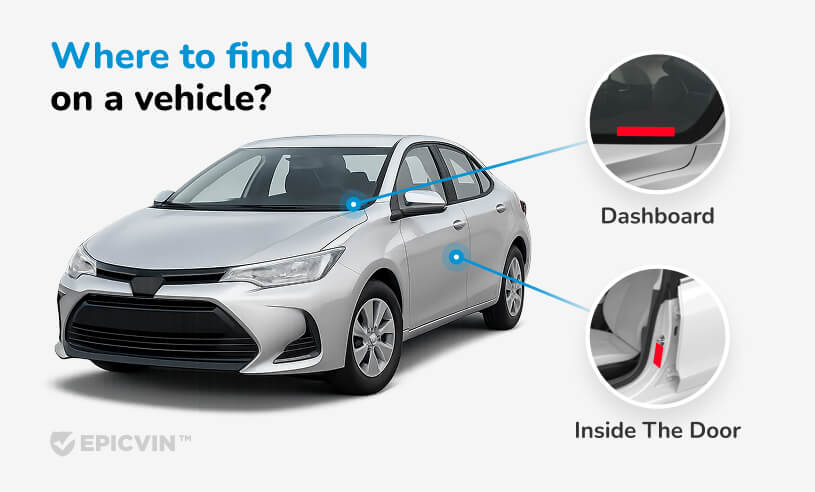
How to Read a VIN Number Like a Pro
From understanding the VIN number breakdown to uncovering a vehicle’s history,...

Free Freightliner VIN Decoder! 🚗 See specs, build sheet, recalls basic history—no sign-up. 🛡️✅ Need accidents, mileage, title? Upgrade in one click.
Looking for the VIN?
Here is there you’ll find it:

A Freightliner vehicle identification number was standardized in 1981 by the ISO Institute. This unique 17-character code provides essential information. Reveal your truck's specifications, manufacturing details, and safety recalls. Our VIN decoder helps buyers verify authenticity and uncover potential issues before purchase.
Freightliner VIN decoder provides instant access to crucial vehicle information through a simple process.

The vehicle identification number appears in several standard places on Freightliner trucks for easy identification.
| Key Risk | Impact on Buyers | Mitigation Steps |
|---|---|---|
| Theft Risk | In 2024, ~7% of Class 8 Freightliner trucks were reported stolen annually. | Install GPS tracking and alarms. |
| Unrepaired Safety Recalls | ~15% have open recalls—airbags/brakes still active. | Always decode VIN, check NHTSA. |
| Depreciation Over Time | Freightliner trucks drop ~25% value in the first 3 years. | Buy low-mileage 2–3 year-old units. |
| Odometer Rollback Fraud | An estimated 2% of used truck listings were altered. | Compare DMV and auction mileage. |
| Hidden Flood or Salvage History | 5% of auctioned Freightliner trucks have undisclosed salvage titles. | Use the EpicVIN timeline-photo view. |
Risk mitigation: Perform VIN lookup verification for open recalls. Check mileage comparison across multiple sources. Examine timeline documents with supporting photographs to safeguard yourself.
| Issue | Affected Models, Symptoms, Average Repair Cost |
|---|---|
| DD15 Injectors Failure | 2018-2022 Cascadia; rough idle, smoke at 200-300k mi; ~$5,000 |
| DEF System Sensor Fault | 2019-2023 Cascadia; warning lights, limp mode; ~$1,200 |
| Turbocharger Oil Leak | 2015-2020 M2/Cascadia; excessive smoke, oil loss; ~$3,500 |

Each character in your vehicle's unique sequence tells a specific story. Our decoder helps identify crucial information about any specific vehicle.
There are some other details that Freightliner owners and buyers should know:
Here's how our Freightliner VIN decoder interprets a sample sequence (using VIN: 1FUWDZYB7YPG60253):
| Symbols | Sample | What It Reveals |
|---|---|---|
| 1 | 1 | The United States as the country of origin |
| 2 | F | Freightliner as a manufacturer |
| 3 | U | Heavy-duty truck vehicle type |
| 4-8 | WDZYB | Chassis configuration, engine type, GVWR class, model series, and cab style |
| 9 | 7 | Check digit for validation |
| 10 | Y | 2000 model year designation |
| 11 | P | Portland assembly plant location |
| 12-17 | G60253 | Individual vehicle's serial number |
Year 1999
Make Freightliner
Model FL60
Fuel Type Diesel
Engine 5.9L In-Line B5.9/ISB
Made in USA
Our comprehensive Freightliner VIN lookup reveals extensive vehicle details beyond basic specifications and helps identify the vehicle's history.
Our timeline-photo archive reveals hidden issues like flood damage before you bid— Alex Black, CMO, EpicVIN
Check the vehicle's VIN on the driver's door frame, dashboard through windshield, or motor compartment chassis rail.
Position 7 typically indicates cab configuration, including sleeper dimensions and roof height specifications for heavy-duty truck models.
Basic structure remains identical, but positions 4-8 contain specialized chassis codes for vocational and specialty applications. Refer to our decoder for details.
Yes, specific engine and transmission codes identify glider kit configurations versus complete factory-assembled vehicles through our VIN lookup service.
The letter "P" in position 11 identifies Portland assembly plant production for most Freightliner models and popular model variants.
Position 6 typically contains chassis specifications, including frame rail dimensions and structural capacity ratings for Freightliner trucks and vans.
Market destination code in the VIS section indicates export models configured for right-hand drive countries. Our decoder helps identify these variations.
Modern Freightliner VINs include a safety equipment code that identifies collision avoidance and mitigation system installations across vehicle models.
VIN standards evolved over time, with advanced safety and emissions codes added as regulations changed. Reliability of older vehicle documentation may vary across company records.
The VDS section contains chassis configuration data that can identify wheelbase measurements for specific model applications. Search our database to decode this information about any car or truck chassis specifications.
Discover expert tips, news and advice on buying and maintaining used vehicles

From understanding the VIN number breakdown to uncovering a vehicle’s history,...

Read this article to discover about car registration.

Our team will tell you about sensors for cars.